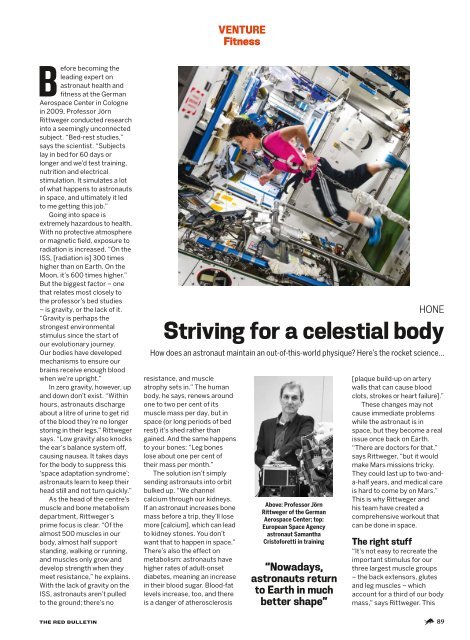Create successful ePaper yourself
Turn your PDF publications into a flip-book with our unique Google optimized e-Paper software.
VENTURE<br />
Fitness<br />
Before becoming the<br />
leading expert on<br />
astronaut health and<br />
fitness at the German<br />
Aerospace Center in Cologne<br />
in 2009, Professor Jörn<br />
Rittweger conducted research<br />
into a seemingly unconnected<br />
subject. “Bed-rest studies,”<br />
says the scientist. “Subjects<br />
lay in bed for 60 days or<br />
longer and we’d test training,<br />
nutrition and electrical<br />
stimulation. It simulates a lot<br />
of what happens to astronauts<br />
in space, and ultimately it led<br />
to me getting this job.”<br />
Going into space is<br />
extremely hazardous to health.<br />
With no protective atmosphere<br />
or magnetic field, exposure to<br />
radiation is increased. “On the<br />
ISS, [radiation is] 300 times<br />
higher than on Earth. On the<br />
Moon, it’s 600 times higher.”<br />
But the biggest factor – one<br />
that relates most closely to<br />
the professor’s bed studies<br />
– is gravity, or the lack of it.<br />
“Gravity is perhaps the<br />
strongest environmental<br />
stimulus since the start of<br />
our evolutionary journey.<br />
Our bodies have developed<br />
mechanisms to ensure our<br />
brains receive enough blood<br />
when we’re upright.”<br />
In zero gravity, however, up<br />
and down don’t exist. “Within<br />
hours, astronauts discharge<br />
about a litre of urine to get rid<br />
of the blood they’re no longer<br />
storing in their legs,” Rittweger<br />
says. “Low gravity also knocks<br />
the ear’s balance system off,<br />
causing nausea. It takes days<br />
for the body to suppress this<br />
‘space adaptation syndrome’;<br />
astronauts learn to keep their<br />
head still and not turn quickly.”<br />
As the head of the centre’s<br />
muscle and bone metabolism<br />
department, Rittweger’s<br />
prime focus is clear. “Of the<br />
almost 500 muscles in our<br />
body, almost half support<br />
standing, walking or running,<br />
and muscles only grow and<br />
develop strength when they<br />
meet resistance,” he explains.<br />
With the lack of gravity on the<br />
ISS, astronauts aren’t pulled<br />
to the ground; there’s no<br />
HONE<br />
Striving for a celestial body<br />
How does an astronaut maintain an out-of-this-world physique? Here’s the rocket science…<br />
resistance, and muscle<br />
atrophy sets in.” The human<br />
body, he says, renews around<br />
one to two per cent of its<br />
muscle mass per day, but in<br />
space (or long periods of bed<br />
rest) it’s shed rather than<br />
gained. And the same happens<br />
to your bones: “Leg bones<br />
lose about one per cent of<br />
their mass per month.”<br />
The solution isn’t simply<br />
sending astronauts into orbit<br />
bulked up. “We channel<br />
calcium through our kidneys.<br />
If an astronaut increases bone<br />
mass before a trip, they’ll lose<br />
more [calcium], which can lead<br />
to kidney stones. You don’t<br />
want that to happen in space.”<br />
There’s also the effect on<br />
metabolism: astronauts have<br />
higher rates of adult-onset<br />
diabetes, meaning an increase<br />
in their blood sugar. Blood-fat<br />
levels increase, too, and there<br />
is a danger of atherosclerosis<br />
Above: Professor Jörn<br />
Rittweger of the German<br />
Aerospace Center; top:<br />
European Space Agency<br />
astronaut Samantha<br />
Cristoforetti in training<br />
“Nowadays,<br />
astronauts return<br />
to Earth in much<br />
better shape”<br />
[plaque build-up on artery<br />
walls that can cause blood<br />
clots, strokes or heart failure].”<br />
These changes may not<br />
cause immediate problems<br />
while the astronaut is in<br />
space, but they become a real<br />
issue once back on Earth.<br />
“There are doctors for that,”<br />
says Rittweger, “but it would<br />
make Mars missions tricky.<br />
They could last up to two-anda-half<br />
years, and medical care<br />
is hard to come by on Mars.”<br />
This is why Rittweger and<br />
his team have created a<br />
comprehensive workout that<br />
can be done in space.<br />
The right stuff<br />
“It’s not easy to recreate the<br />
important stimulus for our<br />
three largest muscle groups<br />
– the back extensors, glutes<br />
and leg muscles – which<br />
account for a third of our body<br />
mass,” says Rittweger. This<br />
THE RED BULLETIN 89

















